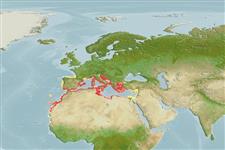Common names from other countries
Environment: milieu / climate zone / depth range / distribution range
Ecologia
marino demersale; distribuzione batimetrica 5 - 100 m (Ref. 2739). Subtropical; 45°N - 12°N, 19°W - 36°E
Eastern Atlantic: Portugal and the Canary Islands, south to Senegal. Also throughout the western and the eastern Mediterranean.
Length at first maturity / Size / Peso / Age
Maturity: Lm 7.8 range ? - ? cm
Max length : 25.0 cm TL maschio/sesso non determinato; (Ref. 2739); common length : 15.0 cm TL maschio/sesso non determinato; (Ref. 26999)
Found over seagrass, sand, mud and rocks (Ref. 2739). Carnivorous, decapods dominate the diet. Adapts well in an aquarium (Ref. 12382). A synchronous hermaphrodite (Ref. 56921).
Life cycle and mating behavior
Maturities | Riproduzione | Spawnings | Egg(s) | Fecundities | Larve
Manifests synchronous hermaphroditism, particularly, differentiation of the ovary is earlier than that of the testis (Ref. 56921).
Smith, C.L., 1990. Serranidae. p. 695-706. In J.C. Quero, J.C. Hureau, C. Karrer, A. Post and L. Saldanha (eds.) Check-list of the fishes of the eastern tropical Atlantic (CLOFETA). JNICT, Lisbon; SEI, Paris; and UNESCO, Paris. Vol. 2. (Ref. 3589)
IUCN Red List Status (Ref. 130435)
CITES (Ref. 128078)
Not Evaluated
Threat to humans
Harmless
Human uses
Pesca: scarso interesse commerciale; Acquario: Commerciale
Strumenti
Special reports
Download XML
Fonti Internet
Estimates based on models
Preferred temperature (Ref.
115969): 14.3 - 21, mean 18.3 (based on 184 cells).
Phylogenetic diversity index (Ref.
82804): PD
50 = 0.5000 [Uniqueness, from 0.5 = low to 2.0 = high].
Bayesian length-weight: a=0.01175 (0.01013 - 0.01363), b=3.04 (3.00 - 3.08), in cm Total Length, based on LWR estimates for this species (Ref.
93245).
Trophic level (Ref.
69278): 3.5 ±0.4 se; based on diet studies.
Resilienza (Ref.
120179): Medio, tempo minimo di raddoppiamento della popolazione 1.4 - 4.4 anni (Preliminary K or Fecundity.).
Fishing Vulnerability (Ref.
59153): Moderate vulnerability (37 of 100).
